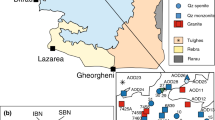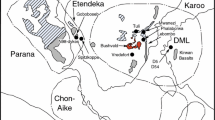Abstract
One of the major puzzles presented by the geochemistry of the Palaeocene plateau lavas of Skye and Mull (N.W. Scotland) is that, although a very strong case can be made that the magmas are variably isotopically contaminated by Archaean Lewisian continental crust, little evidence has been gleaned to date from their major- and trace-element compositions to illuminate this hypothetical process. The combined results of published Sr-, Nd- and Pb-isotope studies of these lavas allow the basalts and hawaiites to be divided into three broad groups: essentially uncontaminated; contaminated with granulite-facies Archaean crust; contaminated with amphibolite-facies Archaean crust. Members of each group show distinctive chondrite-normalised incompatible-element patterns. The processes which gave rise to isotopic contamination of these lavas also affected the abundances and ratios of Ba, Rb, Th, K, Sr and light REE in the magmas, whilst having negligible effects on their abundances and ratios of Nb, Ta, P, Zr, Hf, Ti, Y and middle-heavy REE. Because such a wide range of elements were affected by the contamination process, it is postulated that the contaminant was a silicate melt of one or more distinctive crustal rock types, rather than an aqueous or similar fluid causing selective elemental movements from wall rocks into the magmas. As previous experimental and isotopic studies have shown that the Skye and Mull basic magmas were not constrained by cotectic equilibria at the time when they interacted with sial, the compositions of the contaminated lavas have been modelled in terms of simple magma-crust mixtures. Very close approximations to both the abundances and ratios of incompatible elements in the two groups of contaminated basalts may be obtained by adding 15% to 20% of Lewisian leucogneisses to uncontaminated Palaeocene basalt. Nevertheless, major-element constraints suggest that the maximum amount of granitic contaminant which has been added to these magmas lies between 5% and 10%. These estimates may be reconciled by postulating that the contaminants were large-fraction cotectic partial melts of Lewisian leucogneisses, leaving plagioclase residua. A corollary of this hypothesis is that it is necessary to postulate that the “magma chambers” where the sialic contamination occurred were, in fact, dykes or (more probably) sills. The very large surface-to-volume ratios of such magmas bodies would permit the systematic stripping, by partial melting, of the most-easily-fusible leucogneisses and pegmatites from the Lewisian crust, whilst failing to melt its major rock types. A present-day analogue to this situation may be the extensive sill-like magma bodies detected by geophysical methods within the continental crust beneath the Rio Grande Rift, southwestern U.S.A.
Similar content being viewed by others
References
Alexander PO, Gibson IL (1977) Rare earth abundances in Deccan Trap basalt. Lithos 10:143–147
Bamford D, Nunn K, Prodehl C, Jacob B (1977) LISPB-III. Upper crustal structure of northern Britain. J Geol Soc London 133:481–488
Beckinsale RD, Pankhurst RJ, Skelhorn RR, Walsh JN (1978) Geochemistry and petrogenesis of the Early Tertiary lava pile of the Isle of Mull, Scotland. Contrib Mineral Petrol 66:415–427
Bravo MS, O'Hara MJ (1975) Partial melting of phlogopite-bearing synthetic spinel- and garnet-lherzolites. Phys Chem Earth 9:845–854
Carter SR, Evensen NM, Hamilton PJ, O'Nions RK (1978) Nd- and Sr-isotopic evidence for crustal contamination of continental volcanics. Science 202:743–747
Carter SR, Evensen NM, Hamilton PJ, O'Nions RK (1979) Basalt magma sources during the opening of the North Atlantic. Nature 281:28–30
Cohen RS, Evensen NM, Hamilton PJ, O'Nions RK (1980) U-Pb, Sm-Nd and Rb-Sr systematics of mid-ocean ridge basalt glasses. Nature 283:149–153
Dickin AP (1981) Isotope geochemistry of Tertiary igneous rocks from the Isle of Skye, Scotland. J Petrol 22:155–189
Drury SA (1972) The chemistry of some granitic veins from the Lewisian of Coll and Tiree, Argyllshire, Scotland. Chem Geol 9:175–193
Drury SA (1980) Lewisian pyroxene gneisses from Barra and the geochemistry of the Archaean lower crust. Scott J Geol 16:199–207
Dupré B, Allègre CJ (1980) Pb-Sr-Nd isotopic correlation and the chemistry of the North Atlantic mantle. Nature 286:17–22
Giletti BJ, Moorbath S, Lambert RStJ (1961) A geochronological study of the metamorphic complexes of the Scottish Highlands. QJ Geol Soc London 117:233–272
Gordon GE, Randal K, Goles GG, Corliss JB, Beeson MH, Oxley SS (1968) Instrumental activation analysis of standard rocks with high resolution X-ray detectors. Geochim Cosmochim Acta 32:369–396
Hawkesworth CJ, Morrison MA (1978) A reduction in87Sr/86Sr during basalt alteration. Nature 276:381–383
Holland JG, Lambert RStJ (1972) Chemical petrology and K-Ar ages of the Lewisian gneisses of Rona, near Skye, Scotland. Geol Mag 109:339–347
Kyle PR (1980) Development of heterogeneities in the subcontinental mantle: evidence from the Ferrar Group, Antarctica. Contrib Mineral Petrol 73:89–104
Kushiro I (1975) On the nature of silicate melt and its significance in magma genesis: regularities in the shift of the liquidus boundaries involving olivine, pyroxene and silica minerals. Am J Sci 275:411–431
Lyon TDB, Gillen C, Bowes DR (1975) Rb-Sr isotopic studies near the major Precambrian junction, between Scourie and Loch Laxford, northwest Scotland. Scott J Geol 11:333–337
Mattey DP (1980) The petrology of high-calcium, low-alkali tholeiite dykes from the Isle of Skye regional swarm. Univ London Ph D thesis, unpubl
Moorbath S, Thompson RN (1980) Strontium isotope geochemistry and petrogenesis of the early Tertiary lava pile of the Isle of Skye, Scotland, and other basic rocks of the British Tertiary Province: an example of magma-crust interaction. J Petrol 21:295–321
Moorbath S, Welke H (1969) Lead isotope studies on igneous rocks from the Isle of Skye, northwest Scotland. Earth Planet Sci Lett 5:217–230
Morrison MA (1978) The use of “immobile” trace elements to distinguish palaeotectonic affinities of metabasalts: applications to the Palaeocene basalts of Mull and Skye, NW Scotland. Earth Planet Sci Lett 39:407–416
Morrison MA, Thompson RN, Gibson IL, Marriner GF (1980) Lateral chemical heterogeneity in the Palaeocene upper mantle beneath the Scottish Hebrides. Philos Trans R Soc London A297:229–244
Norry MJ, Truckle PH, Lippard SJ, Hawkesworth CJ, Weaver SD, Marriner GF Isotopic and trace element evidence from lavas, bearing on mantle heterogeneity beneath Kenya. Philos Trans R Soc London A297:259–271
O'Hara MJ, Mathews RE (1981) Geochemical evolution in an advancing, periodically replenished, periodically tapped, continuously fractionated magma chamber. J Geol Soc London 138:237–277
Patchett PJ (1980) Thermal effects of basalt on continental crust and crustal contamination of magmas. Nature 283:559–561
Piwinskii AJ (1968) Experimental studies of igneous rock series, Central Sierra Nevada batholith, California. J Geol 76:548–570
Pushkar P, Stoeser DB (1975)87Sr/86Sr ratios in some volcanic rocks and some semifused inclusions of the San Francisco volcanic field. Geology 3:669–671
Rinehart EJ, Sanford AR, Ward RM (1979) Geographic extent and shape of an extensive magma body at midcrustal depths in the Rio Grande Rift near Socorro, New Mexico. In: RE Riecker (ed) Rio Grande Rift: tectonics and magmatism, pp 237–251. Am Geophys Union
Rollinson HR, Windley BF (1980) An Archaean granulite-grade tonalite-trondhjemite-granite suite from Scourie, NW Scotland: geochemistry and origin. Contrib Mineral Petrol 72:265–281
Sheraton JW, Skinner AC, Tarney J The geochemistry of the Scourian gneisses of the Assynt district. In: RG Park, J Tarney (eds) The early precambrian of Scotland and related rocks of Greenland) pp 13–30, Keele Univ Press 1973
Staudigel H, Zindler A (1978) Nd- and Sr-isotope compositions of potassic volcanics from the East Eifel, Germany: implications for mantle source region. Geol Soc Am Abstr Progr 10:497
Sun S-S (1980) Lead isotopic study of young volcanic rocks from mid-ocean ridges, ocean islands and island arcs. Philos Trans R Soc London A297:409–445
Thompson RN (1974) Primary basalts and magma genesis. I. Skye, North-West Scotland. Contrib Mineral Petrol 45:317–341
Thompson RN (1981) Thermal aspects of the origin of Hebridean Tertiary acid magmas. I. An experimental study of partial fusion of Lewisian gneisses and Torridonian sediments. Mineral Mag 44:161–170
Thompson RN (1982) Magmatism of the British Tertiary Volcanic Province. Scott J Geol 18:49–107
Thompson RN, Esson J, Dunham AC (1972) Major element chemical variation in the Eocene lavas of the Isle of Skye, Scotland. J Petrol 13:219–253
Thompson RN, Gibson IL, Marriner GF, Mattey DP, Morrison MA (1980a) Trace-element evidence of multistage mantle fusion and polybaric fractional crystallisation in the Palaeocene lavas of Skye, NW Scotland. J Petrol 21:265–293
Thompson RN, Morrison MA, Gibson IL, Dickin AP (in press) The Staffa Magma Type revisited... and re-instated. J Geol Soc
Thompson RN, Morrison MA, Mattey DP, Dickin AP, Moorbath S (1980b) An assessment of the Th-Hf-Ta diagram as a discriminant for tectono-magmatic classifications and in the detection of crustal contamination of magmas. Earth Planet Sci Lett 50:1–10
Tuttle OF, Bowen NL (1958) Origin of granite in the light of experimental studies in the system NaAlSi3O8-KAlSi3O8-SiO2-H2O. Mem Geol Soc Am 74
Weaver BL, Tarney J (1980) Rare earth geochemistry of Lewisian granulite-facies gneisses, northwest Scotland: implications for the petrogenesis of the Archaean lower continental crust. Earth Planet Sci Lett 51:279–296
Weaver BL, Tarney J (1981) Lewisian gneiss geochemistry and Archaean crustal development models. Earth Planet Sci Lett 55:171–180
Wood DA (1979) Dynamic partial melting: its application to the petrogenesis of basalts erupted in Iceland, the Faeroe Islands, the Isle of Skye (Scotland) and the Troodos Massic (Cyprus). Geochim Cosmochim Acta 43:1031–1046
Author information
Authors and Affiliations
Rights and permissions
About this article
Cite this article
Thompson, R.N., Dickin, A.P., Gibson, I.L. et al. Elemental fingerprints of isotopic contamination of hebridean Palaeocene mantle-derived magmas by archaean sial. Contr. Mineral. and Petrol. 79, 159–168 (1982). https://doi.org/10.1007/BF01132885
Received:
Accepted:
Issue Date:
DOI: https://doi.org/10.1007/BF01132885




